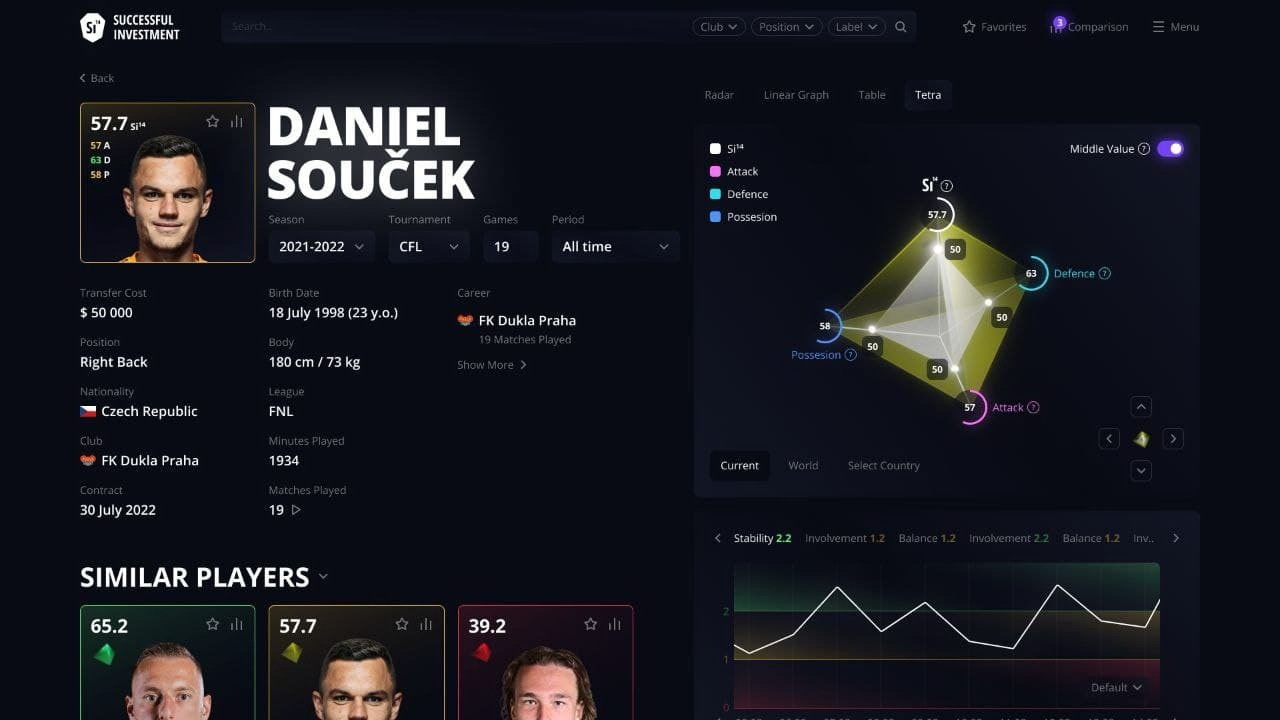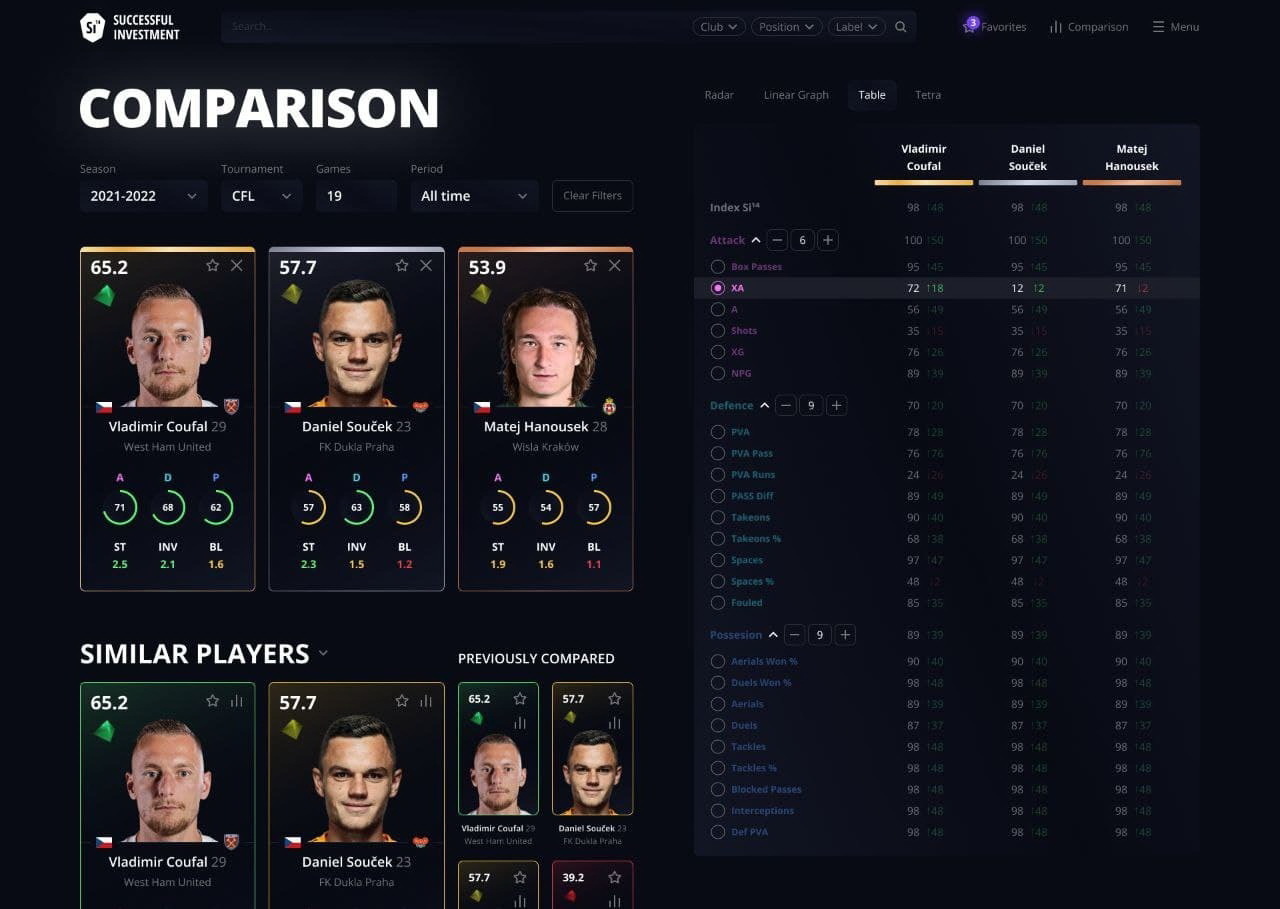We have learned to calculate the probability of each game's outcome. So what exactly is the analytics product of the Si14 betting exchange?
Si14 is a betting exchange which is about to be launched. They claim that their football analytics product is going to be a breakthrough in this industry. Alexei Tryputen, head of the company’s analytical department explains what this innovation is and how to use it in practice.

From raw data to interpretation of numbers
What’s the idea of your analytical solution?
We tried to breathe new life into the vast amounts of football statistical data which exists today. A thing came to our minds once. Analytical companies can count every action a player takes on the field. However, they’re not ready to provide users with some applied recommendations. Those who receive statistics can see information about passes, rebounds, attempts on target, tackles. The evaluation of how useful this is is very approximate or it is made via the direct scoring data, i.e. numbers of goals scored and successful passes made. However, football is a fusion of a particular player’s abilities combined with the work of the team. There are very talented football players that can do overall harm to the team. Also the opposite exists, discreet heroes can save a difficult game.
This led us to a switch from the raw data that statistics companies offer to analytics based on artificial intelligence, which has almost never been applied to the football industry. We got numbers from 211 federations, 130 000 football players, and a huge number of clubs to get an interpretation of those numbers using our quality computer technologies.
What exactly is the quality-made interpretation?
In fact, we have made up a way to understand whether a player is good or not without digging through tons of charts. We can get the overall results and particular characteristics. We can learn his weak and strong areas. We can see how much he is compatible with particular tactics, a league, or a team. It’s possible to understand how coaches, transfers, injuries, and even weddings affect a player's progression or regression.
We use the same raw data but we imply our own mathematical models and our interpretation. At the beginning we detected three components that make up the evaluation of every player with the help of AI. These components are offensive skills, defensive skills, and quality of working with the ball. The next things which are taken into account are a share of the player's actions in the team’s performance, how stable a player is throughout a game, a tournament or a career. The main components’ balance that can tell a one-dimensional player from a versatile one is added, too. This doesn’t let you see a full picture if you review the details separately, but it works when it’s all joined.
Other companies must have tried to do something similar. What’s your know-how?
We have invented average digital portraits for various positions, leagues, styles of play, so-called patterns. We started with processing around a thousand players. We detected over a hundred of the most important metrics for each of them. Every next data array was correcting our models and making them more precise. The database was filled in with a large number of players in the end. Now thanks to the patterns the computer knows for sure if a player is good enough for particular conditions.
I’ll give you an example of John Stones from Manchester City. Some software may think that tackling is a weak point for him if we use a linear approach. However, John is a top defender with elite qualities specific to this position. We made an analysis of the other league and we found several good defenders without high numbers in tackles. We found out that they all played in the teams that had overwhelming advantage on the field. Defenders never needed to tackle as much if the opponents don’t apply much pressure. Besides, coaches tend to use such defenders in offensive actions. This is why a typical software would consider them weak in defensive performance. The Si14 algorithm can separate this case, create a pattern, which will be applied to similar situations.
Which volume of data is needed for the patterns to be formed?
Around 1 500 - 2000 games are played across the world weekly. Around 2 000 stactical events happen each game. And 4 million numbers are updated in our computer within seven days. Is it much? In fact, it’s not if we compare it with insurance or financial business. We do compare them, and we imply the evaluation system that insurance business use. It is called a solution tree. It’s a branched logical classification. Every player goes through a row of comparisons with an ideal pattern and makes it even more precise simultaneously.
How can a user of your betting exchange see the results of AI work?
We’re proud that we’ve made up a visualization of the players’ evaluation, this is the Si14 index. These are so-called tetrahedrons, which are computer graphics that allow to evaluate complicated football components visually.

Our tetrahedron is a statistical portrait of a football player, made in a minimalistic way. It’s a simple geometrical code that has a comprehensible colour range. Green stands for quality, red means some disadvantages. A long bar describes a strong side of a player, while a short side describes a weaker side. The Tetrahedron image characterizes the level of every football player. In case there’s a need to decipher it, each part of the Si14 index is clickable and ready to send a user to a bright digital journey.
Football players’ patterns, digitalising, and their skills visualization have been a part of football simulators, like FIFA, for decades, haven’t they?
Of course, it’s true. However, there’s an important difference. All numbers and data that we provide is based upon the real data gained by players on the pitch. In the case of simulators, those numbers are just an imagination of developers and the way they see football. The visual part, for example, our tetrahedron, length of its edges, volume of the ball at the corners, colour code - green, yellow, and red - is just a way of visual perception of the data.
How to use this in betting
Now let’s talk about the most important thing. How can bettors apply your tetrahedrons and why do they need it?
We started with the players indexes and came to clubs and leagues indexes, now we can calculate them with the same depth and accuracy. This has led to a solution that allows us to evaluate possibilities of an outcome of games, number of goals scored, number of corner kicks served, every component of a game. Our rate is based upon real football strength of teams in question instead of a subjective opinion of analytics that build the odds manually. This is an online statistical summary of an upcoming game.
Of course, all these things are tightly connected to our main area which is betting. Most bookmakers use the same model today. They buy events and markets from Betradar, StatsPerform or they use services of special companies like OpenBet that offer software for creating lines automatically. Then an own margin is placed over the odds. The markets are formed based on historical databases and the subjective opinion of analytics. Such a model is highly inaccurate. But the liability that a bookmaker may face can be cushioned by a margin and the market's adjustments after the first bets are made. Even if a bookmaker offered inaccurate odds, they just change them, reacting to the market.
We have a completely different approach. Our model forms markets based on deep analysis with the help of AI. There’s no analogue for this. If we’d pick a name for it, I would stop at ‘calculation of true odds’.
Could you give us an example? Burnley faced Watford in the Premier League game on February 5. What odds did your system offer for this match?
The odds are just a derivative of our evaluation of the possibility of the outcome of a game. It’s important to understand that we aren’t oracles, we haven’t found the ***** Grail that can predict the outcomes of games. It’s impossible for objective reasons. We believe that our system of evaluation of players, teams, possibility of the outcome of games is deep, objective, and at least competitive to the current evaluations. The thing is that today historical data applied to forming the odds is often inaccurate. I’ll give you an example.
Over 80% of transfers in modern football are done without paying a transfer fee. Players sign short-term contracts to leave a club for another one as soon as possible. Their motivation is clear. If a club doesn’t have to pay money for your transfer you can ask the same amount as a starter pack or to increase your salary. This system leads to the situation when most clubs refresh their line ups annually changing at least half of the players, sometimes completely. What’s the use from the historical data or head-to-head history if this year line ups are totally different? In our case we make steps from one part to another evaluating players that will take part in a particular game.
A real story to confirm what I say. Union, the current leader of the Belgian league, and Aris Limassol, currently 2nd in the Cypriot championship, were in lower leagues in the previous season. They should be considered outsiders after promotion due to historical evaluation. However, both clubs have completely renewed their line ups and now they’re strong enough to be leaders in the middle of the course of their championships. Our evaluation system would have defined their strength correctly from the first fixture.
Is AI completely responsible for your odds or is there a team of traders?
Artificial intelligence only. People are only needed to control the process, checking if everything works correctly.
In case your line will be too different from what other providers offer, a situation for arbitrage betting can emerge. Although as far as I remember you’re not afraid of such situations.
We are a betting exchange, not a bookmaker. This is why we’re interested in fair conditions for betting for our customers right from the start. It means it should contain fair ‘true odds’.
We don’t want an imbalance due to the volume of bets to emerge. Bookmaker lines are typically affected by many factors. From silly rumors to videos of bloggers. Someone has placed many bets on an outcome and it’s not objective anymore. But it’s not our case. We want to try another way. We want to use a mathematical model to build the odds. We’d like to base it upon knowledge instead of following the money. Handicappers will have a chance to rely on football reasons only by using Si14. They won’t depend on someone else’s hedging, for example, on media influence.
So, you claim you have a tool that gives you a chance to calculate the possible outcome of sport events correctly, right?
Absolutely. It is based on statistics processed according to a logical and comprehensible algorithm only. We’re ready to give this tool to those who are involved in betting. Just fans or analytics companies.
We’re going to use our own odds offering them to the clients of the betting exchange. However, companies that sell events to bookmakers are already really interested in this. We’re hoping we will have mutually beneficial partnerships. Why not become a Betradar for Betradars?
Why will a Betradar pay you?
It’s very simple. Such companies are interested in offering a quality line to their customers. To be able to offer such lines they need to get rid of imbalance or errors. With our data they will get an improved product, which reflects reality more precisely. As I’ve already mentioned providers are really interested in this. Of course, I can’t name particular companies.
AI knows what the others thought
I realise that you’re not the person who can answer this question. Still. Is it worth it? Several years of development, a lot of spending, but your odds are just a benchmark for users of the betting exchange. Haven’t you increased the period of getting to a break-even point?
The thing is that the platform was created initially as a product for professional football clubs. We spent around three years developing it. We realised that we could solve bigger issues after we connected software to AI. Now we can use our software for betting and offer it to the professional clubs. We have a wide range of partnerships with clubs, from scouting to helping to choose a starting line up based on an opponent. Fans can trace the changes the players of their favourite teams go through in various periods. Presidents of the clubs can understand how a new coach affected a team. Any monitoring period is available so you can see the dynamics of processes. Club analytics, scouts, agents are interested in this product, too. Everyone can find useful information in the Si14 index.
AI doesn’t think but it knows what the others thought. That’s why it chooses the shortest way to the target. By the way another index we’re working on is for coaches. There are a lot of metrics that characterise the people of this profession. And many parameters that allow us to make statistical patterns for comparison.
Do you have only football analytics for now?
No. If people like handball, horse racing or games of the second division of Finland more they will be able get recommendations based on statistics. There will be an “Analytics” button beside every odds line with full information on leagues, teams, and players.
We started with football. When the algorithm was finally fully functional we decided to take a look around. Now we have contacts with a Western European company, which is one of the leaders of event and fitness data collecting in various sports. They started calculating all this data over five years ago and advanced pretty well in handball, volleyball, and basketball. We only need to apply their data to our evaluating algorithms.
Are there any perspectives in e-sports?
We have some thoughts about it. There’s a chance that e-sports will be a priority for us. Fans tend to go online, Fantasy football, where everyone can imagine they’re coaches or managers, is getting popular. Our model of real evaluation of football players is a must have for such platforms. Gamers get a chance to rank players by particular metrics using the Si14 product. It will automatically make the issue of virtual price, transfer budgets, and applicability horizons very important. Users of gaming platforms will have a chance to earn money knowing the strength of players and clubs in numbers. The world of football simulators will have a new sense and will bring the skills of football fans up to the real professional level.
“Users of gaming platforms will have a chance to earn money”. Are you implying that your product is a tool for earning money?
No, we’re implying that our product is a working tool. It’s an iPhone in your hands. Some need it for work, some to communicate with friends, some to play games.
And the last thing. We interviewed Viktor Kopylov almost a year ago. When will the betting exchange finally be launched? Why is it taking so long?
Let’s not have a comparison with wine that gets better the more it is aged. We don’t have a target to launch and enter the market as soon as possible. We have our current tasks that demand perfect elaboration for such a multi-layered and complicated product like a betting exchange. We’re working on a lot of innovative solutions. There are many details that we should take care of before we break a bottle against the bow of our ship. But we’ll set sail very soon.
Further reading:











